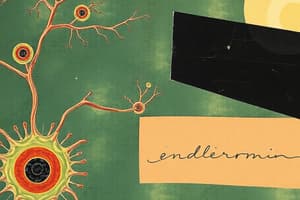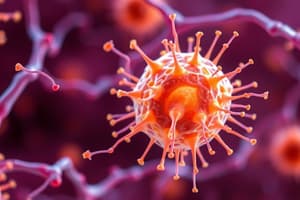Podcast
Questions and Answers
What is the primary characteristic that differentiates endocrine signalling from other types of cell signalling?
What is the primary characteristic that differentiates endocrine signalling from other types of cell signalling?
- Chemicals are released through blood for long-distance action (correct)
- Messages are passed through electrical impulses
- Signals act locally and quickly
- Cell communicate through direct contact with each other
Which of the following is a unique feature of paracrine signalling?
Which of the following is a unique feature of paracrine signalling?
- Signals travel long distances
- Chemicals are distributed via the bloodstream
- It involves electrical impulses for rapid communication
- Effects are localized and only affect nearby cells (correct)
What role does acetylcholine play at the neuromuscular junction?
What role does acetylcholine play at the neuromuscular junction?
- It acts as a hormone regulating blood pressure.
- It inhibits the release of calcium ions in the muscle cells.
- It is involved in muscle contraction through binding to nicotinic receptors. (correct)
- It serves as a secondary messenger for other neurotransmitters.
What type of signalling occurs when a cell sends a signal to itself?
What type of signalling occurs when a cell sends a signal to itself?
Which type of receptor primarily mediates long-term cellular responses?
Which type of receptor primarily mediates long-term cellular responses?
During synaptic signalling, what triggers the release of neurotransmitters into the synaptic cleft?
During synaptic signalling, what triggers the release of neurotransmitters into the synaptic cleft?
What distinguishes nitric oxide from other neurotransmitters?
What distinguishes nitric oxide from other neurotransmitters?
What distinguishes an agonist from an antagonist in cell signalling?
What distinguishes an agonist from an antagonist in cell signalling?
In synaptic transmission, what is the primary role of the neurotransmitters once released?
In synaptic transmission, what is the primary role of the neurotransmitters once released?
What is the main function of eicosanoids in the body?
What is the main function of eicosanoids in the body?
Which aspect of cell signalling determines how a cell responds to a received message?
Which aspect of cell signalling determines how a cell responds to a received message?
Which of the following statements about second messenger signaling is true?
Which of the following statements about second messenger signaling is true?
What mechanism does paracrine signaling utilize?
What mechanism does paracrine signaling utilize?
What is the main function of receptors in cell signalling?
What is the main function of receptors in cell signalling?
Neurotransmitters are typically stored in which structures before release?
Neurotransmitters are typically stored in which structures before release?
Which statement about autocrine signaling is accurate?
Which statement about autocrine signaling is accurate?
Flashcards
Cell Signaling
Cell Signaling
How cells communicate with each other using chemical messengers.
Endocrine Signaling
Endocrine Signaling
Long-distance signaling using hormones released into the bloodstream.
Paracrine Signaling
Paracrine Signaling
Short-range signaling where chemicals diffuse locally between cells.
Synaptic Signaling
Synaptic Signaling
Signup and view all the flashcards
Neurotransmitters
Neurotransmitters
Signup and view all the flashcards
Receptor
Receptor
Signup and view all the flashcards
Agonist
Agonist
Signup and view all the flashcards
Antagonist
Antagonist
Signup and view all the flashcards
What does cell signaling depend on?
What does cell signaling depend on?
Signup and view all the flashcards
Ion channel signaling
Ion channel signaling
Signup and view all the flashcards
Membrane-bound enzyme signaling
Membrane-bound enzyme signaling
Signup and view all the flashcards
G protein-coupled receptor signaling
G protein-coupled receptor signaling
Signup and view all the flashcards
Intracellular receptor signaling
Intracellular receptor signaling
Signup and view all the flashcards
Nitric oxide signaling
Nitric oxide signaling
Signup and view all the flashcards
What are eicosanoids?
What are eicosanoids?
Signup and view all the flashcards
Study Notes
Cell Signalling Overview
- Cell signalling is how cells communicate with each other.
- There are three main types: endocrine, paracrine, and synaptic.
Endocrine Signalling
- Hormones are released by glands.
- Hormones travel through the bloodstream.
- Hormones exert effects on distant cells.
- This type of signalling is slow but has a long-lasting effect.
Paracrine Signalling
- Chemicals are released by cells.
- They act on nearby cells.
- This type of signalling involves localized effects.
- Chemicals don't enter the bloodstream.
Synaptic Signalling
- Nerve cells communicate quickly.
- Messages are sent electrically down the nerve cell.
- When the message reaches the end of the nerve cell, it causes release of a chemical.
- This chemical travels across a small gap.
- The chemical binds to receptors on the target cell.
- This is a very localized process.
Other Key Concepts
- Autocrine signalling: Special case where cells signal themselves.
- Ligands: Molecules that bind to receptors.
- Receptors: Proteins that bind to ligands and trigger a response.
- Signal transduction: Converting one signal into another.
- Response: The effect of the signalling molecule on the target cell.
- Speed of response: Different types of signalling have different speeds, ranging from very fast (synaptic) to relatively slow (endocrine).
- Duration of response: Effect can be short-lived (synaptic) or long-lasting (endocrine).
- Specificity: Different cells react differently to the same signal based on having the appropriate receptors.
- Local effects versus long-range effects: Paracrine and endocrine signalling differ in their reach.
- Methods of signal transmission: Some signals are electrical, others are chemical.
Receptor Types and Function
- Ion channels: Ligand binding opens the channel, allowing ions to flow.
- Membrane bound enzymes: Ligand binding causes the enzyme to activate, leading to a cellular response.
- G protein-coupled receptors: Ligand binding triggers a cascade inside the cell via G-proteins.
- Intracellular receptors: Lipophilic ligands can pass through the membrane and bind to receptors inside the cell.
Moodle Recap Quiz Summary (Questions and Answers)
- Synaptic transmission details: Action potential, neurotransmitter, synaptic cleft, postsynaptic receptor.
- Second messenger signalling features: Different pathways, sustained response, signal amplification.
- Response determination factors: Receptor type, signal level, pathway availability.
- Autocrine signalling definition: Acts on the cell that produces it.
- Paracrine signalling definition: Local effects on neighboring cells.
- Endocrine signalling definition: Long-distance effects via the bloodstream from glands.
- Neurotransmitter packaging: Membrane-bound vesicles.
- Exception: Non-vesicle packaging (e.g., nitric oxide) due to their lipophilic nature.
Studying That Suits You
Use AI to generate personalized quizzes and flashcards to suit your learning preferences.




